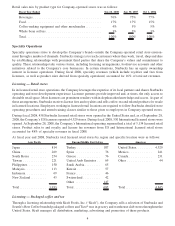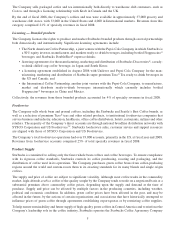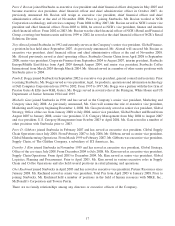Starbucks 2008 Annual Report Download - page 20
Download and view the complete annual report
Please find page 20 of the 2008 Starbucks annual report below. You can navigate through the pages in the report by either clicking on the pages listed below, or by using the keyword search tool below to find specific information within the annual report.level of financial obligations, if any, would have several important effects on the Company’s future operations, such
as:
• additional cash requirements to support the payment of rents and interest on outstanding indebtedness;
• possible increased vulnerability to adverse changes in general economic and industry conditions, as well as
to competitive pressure;
• possible limitations on the Company’s ability to obtain additional financing for working capital, capital
expenditures, general corporate and other purposes; and
• possible limitations on the Company’s flexibility in planning for, or reacting to, changes in its business and
its industry.
The Company’s ability to satisfy its lease obligations and make payments of principal and interest on its
indebtedness depends on its future performance, which will be subject to general economic conditions, industry
cycles and financial, business and other factors affecting its consolidated operations, many of which are beyond the
Company’s control. If Starbucks is unable to generate sufficient cash flow from operations in the future to satisfy its
financial obligations, it may be required, among other things:
• to seek additional financing in the debt or equity markets;
• to refinance or restructure all or a portion of its indebtedness;
• to sell selected assets; or
• to reduce or delay planned capital or operating expenditures.
Such measures might not be sufficient to enable Starbucks to satisfy its financial obligations. In addition, any such
financing, refinancing or sale of assets might not be available on economically favorable terms.
An increase in leverage could lead to deterioration in Starbucks credit ratings. A reduction in its credit ratings,
regardless of the cause, could limit the Company’s availability of additional financing and increase its cost of
obtaining financing.
•Starbucks relies heavily on information technology in its operations, and any material failure, inadequacy,
interruption or security failure of that technology could harm the Company’s ability to effectively operate
its business.
Starbucks relies heavily on information technology systems across its operations, including for management of its
supply chain, point-of-sale processing in its stores, and various other processes and transactions. The Company’s
ability to effectively manage its business and coordinate the production, distribution and sale of its products depends
significantly on the reliability and capacity of these systems. The failure of these systems to operate effectively,
problems with transitioning to upgraded or replacement systems, or a breach in security of these systems could
cause delays in product sales and reduced efficiency of the Company’s operations, and significant capital
investments could be required to remediate the problem.
•Failure of the Company to comply with applicable laws and regulations could harm its business and
financial results.
Starbucks policies and procedures are designed to comply with all applicable laws and regulations, including those
imposed by the SEC, NASDAQ, and foreign countries, as well as applicable labor laws. Additional legal and
regulatory requirements, such as those arising under the Sarbanes-Oxley Act of 2002, together with the fact that
foreign laws occasionally conflict with domestic laws, increase the complexity of the regulatory environment in
which the Company operates and the related cost of compliance. Failure to comply with the various laws and
regulations may result in damage to Starbucks reputation, civil and criminal liability, fines and penalties, increased
cost of regulatory compliance and restatements of the Company’s financial statements.
If any of the risks and uncertainties described in the cautionary factors described above actually occurs, Starbucks
business, financial condition and results of operations could be materially and adversely affected. The factors listed
14
























